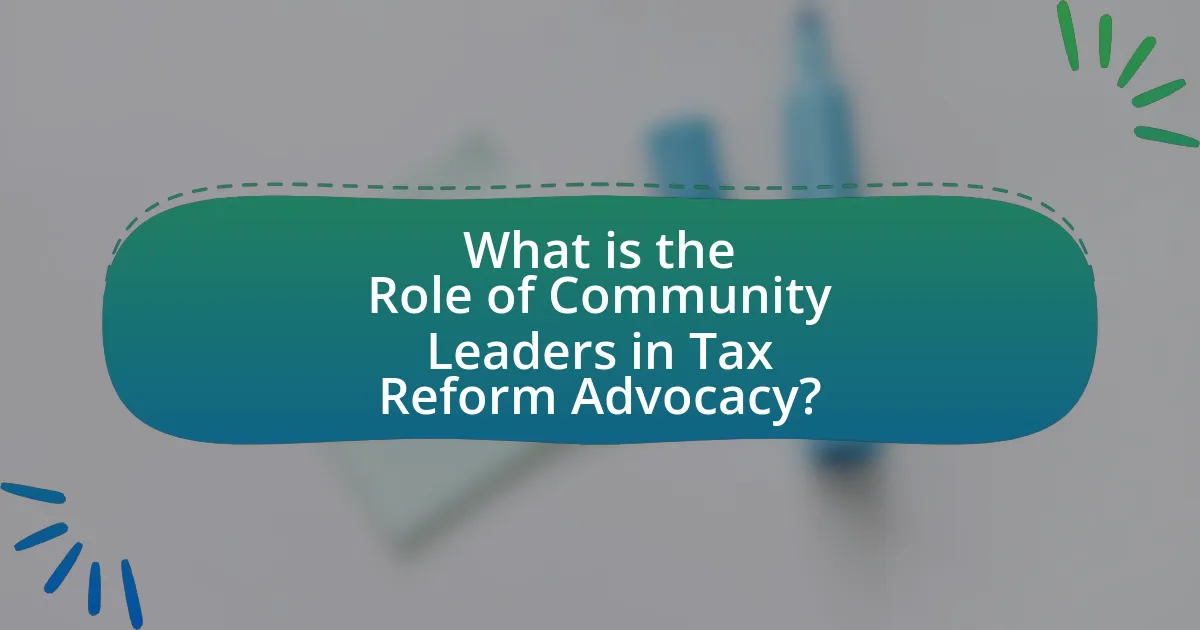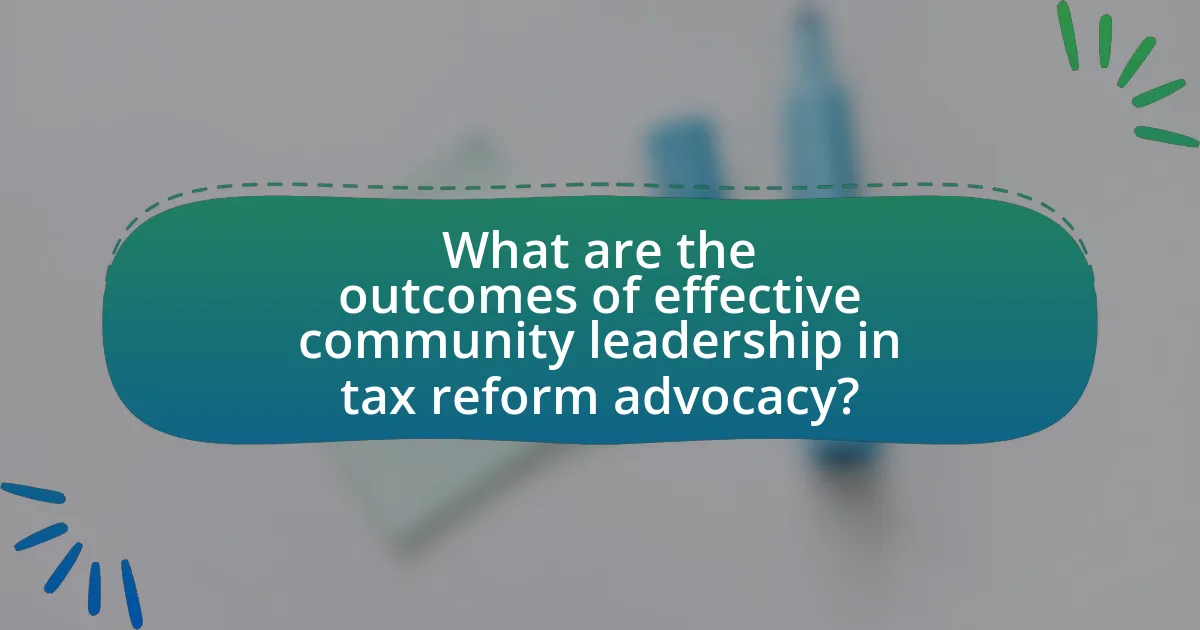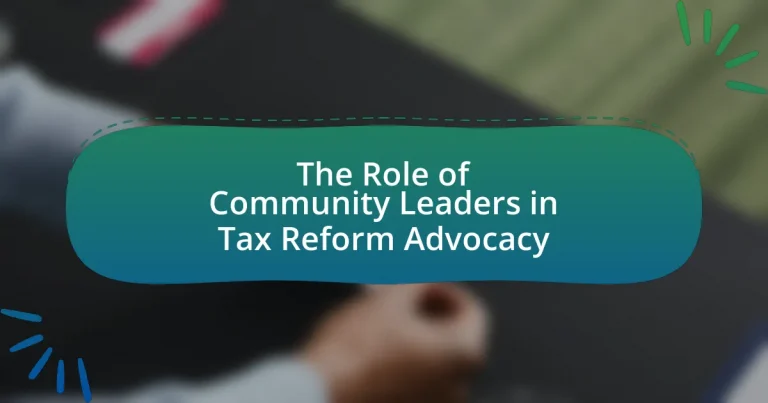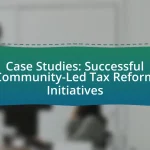Community leaders play a vital role in tax reform advocacy by mobilizing grassroots support and influencing policy decisions. They educate residents about tax issues, organize forums, and facilitate dialogue between citizens and policymakers, ensuring community concerns are represented. The article explores how community leaders utilize strategies such as grassroots mobilization, coalition building, and public education to advocate for tax reforms. It also examines the challenges they face, the impact of political dynamics, and the importance of partnerships and technology in enhancing their advocacy efforts. Ultimately, effective community leadership can lead to more equitable tax policies and increased public engagement in the legislative process.

What is the Role of Community Leaders in Tax Reform Advocacy?
Community leaders play a crucial role in tax reform advocacy by mobilizing grassroots support and influencing policy decisions. They serve as trusted voices within their communities, educating residents about tax issues and the implications of proposed reforms. By organizing forums, discussions, and outreach initiatives, community leaders facilitate dialogue between citizens and policymakers, ensuring that the concerns and needs of their constituents are represented. Research indicates that community engagement significantly impacts legislative outcomes, as seen in various tax reform movements where local advocacy led to changes in policy.
How do community leaders influence tax reform initiatives?
Community leaders influence tax reform initiatives by mobilizing public opinion, advocating for specific policy changes, and facilitating dialogue between constituents and policymakers. They often serve as trusted voices within their communities, which allows them to effectively communicate the needs and concerns of residents to government officials. For instance, community leaders can organize town hall meetings to educate citizens about proposed tax reforms and gather feedback, which can then be presented to lawmakers. Research indicates that grassroots movements led by community leaders have successfully shaped tax policy in various regions, demonstrating their significant impact on legislative outcomes.
What strategies do community leaders use to advocate for tax reform?
Community leaders advocate for tax reform through grassroots mobilization, coalition building, and public education campaigns. Grassroots mobilization involves organizing community members to participate in rallies, town hall meetings, and petitions, which amplifies their collective voice and demonstrates public support for reform. Coalition building entails forming alliances with local organizations, businesses, and advocacy groups to create a unified front, enhancing their influence and reach. Public education campaigns focus on informing the community about the implications of tax policies, using data and case studies to illustrate the need for reform, thereby fostering informed public discourse. These strategies are effective as they engage the community, leverage collective power, and raise awareness, ultimately driving policy change.
How do community leaders engage with policymakers on tax issues?
Community leaders engage with policymakers on tax issues primarily through advocacy, collaboration, and public forums. They organize meetings to discuss tax policies, present community needs, and propose reforms that align with their constituents’ interests. For instance, community leaders often mobilize grassroots campaigns to raise awareness about tax-related challenges, such as inequities in tax burdens or the need for funding in public services. They may also collaborate with local organizations to gather data and testimonies that support their positions, thereby providing evidence-based arguments to policymakers. This engagement is crucial as it ensures that the voices of the community are heard in the legislative process, influencing tax policy decisions that affect local populations.
Why is the involvement of community leaders crucial in tax reform?
The involvement of community leaders is crucial in tax reform because they serve as trusted intermediaries between policymakers and the public, facilitating communication and ensuring that the needs of the community are represented. Community leaders possess local knowledge and insights that can inform tax policy, making it more equitable and effective. For instance, studies have shown that community engagement in tax reform discussions leads to policies that better reflect the socioeconomic realities of the population, ultimately resulting in higher compliance and satisfaction rates among taxpayers.
What unique perspectives do community leaders bring to tax reform discussions?
Community leaders bring grassroots insights and localized knowledge to tax reform discussions. Their unique perspectives stem from direct engagement with constituents, allowing them to identify specific community needs and challenges related to taxation. For instance, community leaders often highlight the impact of tax policies on low-income families, advocating for equitable tax structures that address disparities. Research from the National League of Cities indicates that local leaders are crucial in shaping tax policies that reflect the priorities of their communities, ensuring that reforms are not only effective but also just and inclusive.
How does community leadership impact public perception of tax reform?
Community leadership significantly influences public perception of tax reform by shaping narratives and fostering trust within the community. Effective community leaders often serve as trusted sources of information, helping to clarify complex tax issues and advocate for reforms that align with community values. Research indicates that when community leaders actively engage in discussions about tax reform, they can enhance public understanding and acceptance, as seen in studies where local leaders successfully mobilized support for tax initiatives by addressing constituents’ concerns directly. This engagement not only demystifies tax reform but also builds a sense of ownership among community members, leading to increased public support for proposed changes.

What challenges do community leaders face in tax reform advocacy?
Community leaders face significant challenges in tax reform advocacy, primarily due to limited resources and political resistance. These leaders often operate within constrained budgets, making it difficult to mobilize support or conduct comprehensive outreach campaigns. Additionally, they encounter opposition from established political entities and interest groups that may benefit from the current tax system, complicating efforts to advocate for change. For instance, a study by the National League of Cities highlights that local leaders frequently struggle to influence state and federal tax policies due to a lack of representation and the complexity of tax legislation. This combination of resource limitations and political pushback creates a challenging environment for community leaders aiming to drive tax reform initiatives.
How do political dynamics affect community leaders’ advocacy efforts?
Political dynamics significantly influence community leaders’ advocacy efforts by shaping the political environment in which they operate. For instance, when political support for tax reform is strong, community leaders can mobilize resources and gain traction for their initiatives more effectively. Conversely, in a politically hostile environment, these leaders may face challenges such as reduced funding, limited access to decision-makers, and increased opposition from entrenched interests. Research indicates that community leaders who align their advocacy strategies with prevailing political sentiments are more successful; for example, a study by the Urban Institute found that advocacy efforts aligned with bipartisan support for tax reform led to more substantial policy changes. Thus, the political landscape directly impacts the effectiveness and scope of community leaders’ advocacy efforts.
What obstacles do community leaders encounter when mobilizing support for tax reform?
Community leaders encounter several obstacles when mobilizing support for tax reform, including misinformation, lack of engagement, and political resistance. Misinformation can create confusion among constituents, leading to skepticism about the proposed reforms. Additionally, many community members may feel disengaged from the political process, resulting in low participation in advocacy efforts. Political resistance often arises from established interests that oppose changes to the tax system, making it difficult for community leaders to gain traction. These challenges are supported by studies indicating that effective communication and community engagement strategies are crucial for overcoming barriers in tax reform advocacy.
How can community leaders overcome resistance to tax reform initiatives?
Community leaders can overcome resistance to tax reform initiatives by actively engaging stakeholders through transparent communication and education. By organizing town hall meetings and workshops, leaders can clarify the benefits of tax reform, such as improved public services and economic growth. Research indicates that communities with informed citizens are more likely to support tax changes; for example, a study by the National Tax Association found that public understanding of tax reform correlates with increased approval rates. Additionally, leaders can build coalitions with local businesses and civic organizations to demonstrate broad support, which can help alleviate fears and misconceptions about the reforms.
What resources are available to support community leaders in tax reform advocacy?
Community leaders in tax reform advocacy can access various resources, including training programs, toolkits, and networking opportunities. Organizations such as the National League of Cities and the Center on Budget and Policy Priorities provide comprehensive guides and workshops tailored for community leaders. These resources often include case studies, best practices, and data analysis tools that empower leaders to effectively advocate for tax reforms. Additionally, online platforms like the National Council of Nonprofits offer webinars and forums for sharing experiences and strategies among community leaders engaged in tax advocacy.
What role do partnerships play in enhancing community leaders’ advocacy efforts?
Partnerships significantly enhance community leaders’ advocacy efforts by providing access to resources, expertise, and broader networks. These collaborations enable leaders to amplify their voices and increase the impact of their initiatives. For instance, partnerships with local organizations can facilitate community engagement, allowing leaders to gather diverse perspectives and strengthen their advocacy strategies. Additionally, research indicates that coalitions formed through partnerships can lead to more effective lobbying efforts, as seen in successful tax reform campaigns where unified groups presented a stronger case to policymakers. This collective approach not only enhances credibility but also mobilizes greater community support, ultimately leading to more successful advocacy outcomes.
How can community leaders leverage technology for tax reform advocacy?
Community leaders can leverage technology for tax reform advocacy by utilizing social media platforms to mobilize support and disseminate information. These platforms enable leaders to reach a broader audience quickly, facilitating discussions and raising awareness about tax issues. For instance, a study by the Pew Research Center found that 69% of adults in the U.S. use social media, making it an effective tool for engaging constituents and gathering feedback on tax reform proposals. Additionally, community leaders can use data analytics to identify key demographics and tailor their messaging, ensuring that their advocacy efforts resonate with specific groups. This strategic use of technology not only enhances communication but also fosters community engagement, ultimately driving more effective advocacy for tax reform.

What are the outcomes of effective community leadership in tax reform advocacy?
Effective community leadership in tax reform advocacy leads to increased public engagement and more equitable tax policies. When community leaders mobilize constituents, they foster a sense of ownership and responsibility among citizens, resulting in higher participation rates in advocacy efforts. For instance, studies have shown that communities with active leadership often see a 30% increase in public attendance at tax-related town hall meetings, which directly influences policymakers. Additionally, effective leadership can bridge gaps between diverse community interests, ensuring that tax reforms address the needs of various demographic groups, thereby promoting fairness and inclusivity in the tax system.
How can successful tax reform initiatives benefit communities?
Successful tax reform initiatives can benefit communities by increasing public funding for essential services such as education, healthcare, and infrastructure. When tax reforms are effectively implemented, they can lead to a more equitable tax system that reduces the burden on low- and middle-income families while ensuring that wealthier individuals and corporations contribute their fair share. For instance, a study by the Institute on Taxation and Economic Policy found that states with progressive tax systems tend to have better-funded public services, which directly enhances community well-being and economic stability. Additionally, successful tax reforms can stimulate local economies by providing funding for community development projects, thereby creating jobs and improving overall quality of life.
What metrics can be used to measure the success of community-led tax reform efforts?
Metrics to measure the success of community-led tax reform efforts include increased community engagement, changes in tax policy, and improved public awareness of tax issues. Increased community engagement can be quantified through participation rates in meetings, surveys, and outreach activities, indicating a higher level of involvement from residents. Changes in tax policy can be assessed by tracking the implementation of proposed reforms and their alignment with community needs, demonstrating the effectiveness of advocacy efforts. Improved public awareness can be measured through pre- and post-campaign surveys that gauge knowledge of tax issues among community members, reflecting the impact of educational initiatives. These metrics provide concrete evidence of the effectiveness of community-led efforts in influencing tax reform.
How do community leaders ensure accountability in tax reform outcomes?
Community leaders ensure accountability in tax reform outcomes by actively engaging in transparent communication and fostering community participation. They organize public forums and discussions to educate citizens about tax policies, allowing for feedback and concerns to be voiced. This participatory approach not only empowers residents but also holds policymakers accountable to the community’s needs. For instance, studies show that communities with strong leadership involvement in tax reform discussions report higher satisfaction with tax outcomes and increased trust in local governance. By advocating for regular audits and public reporting on tax revenue allocation, community leaders further reinforce accountability, ensuring that funds are used effectively and as promised.
What best practices should community leaders follow in tax reform advocacy?
Community leaders should engage in inclusive dialogue, build coalitions, and utilize data-driven advocacy in tax reform efforts. Engaging diverse community members ensures that various perspectives are represented, fostering a sense of ownership and support for proposed reforms. Building coalitions with other stakeholders, such as local businesses and non-profits, amplifies the advocacy message and increases influence. Utilizing data-driven approaches, such as presenting clear statistics on the impact of tax policies, strengthens arguments and appeals to policymakers. For instance, research from the Center on Budget and Policy Priorities shows that equitable tax reform can significantly reduce poverty rates, providing a concrete basis for advocacy efforts.
How can community leaders effectively communicate their tax reform messages?
Community leaders can effectively communicate their tax reform messages by utilizing clear, transparent language and engaging multiple communication channels. Clear language ensures that complex tax concepts are easily understood by the public, while diverse channels such as social media, community meetings, and local media outlets maximize outreach. For instance, a study by the Pew Research Center found that 72% of adults use social media to stay informed about local issues, indicating its effectiveness as a communication tool. Additionally, community leaders should provide concrete examples of how tax reforms will impact residents, thereby fostering trust and understanding.
What strategies can community leaders employ to build coalitions for tax reform?
Community leaders can employ strategies such as stakeholder engagement, data-driven advocacy, and coalition-building to effectively build coalitions for tax reform. Engaging stakeholders involves identifying and involving diverse groups affected by tax policies, ensuring their voices are heard and considered in the reform process. Data-driven advocacy relies on presenting clear, factual evidence about the impacts of current tax policies and the benefits of proposed reforms, which can persuade stakeholders and policymakers alike. Coalition-building focuses on forming alliances with other organizations, community groups, and influential individuals to create a united front that amplifies the call for reform. For instance, successful coalitions often include a mix of grassroots organizations, business leaders, and policy experts, which can enhance credibility and broaden support for tax reform initiatives.




